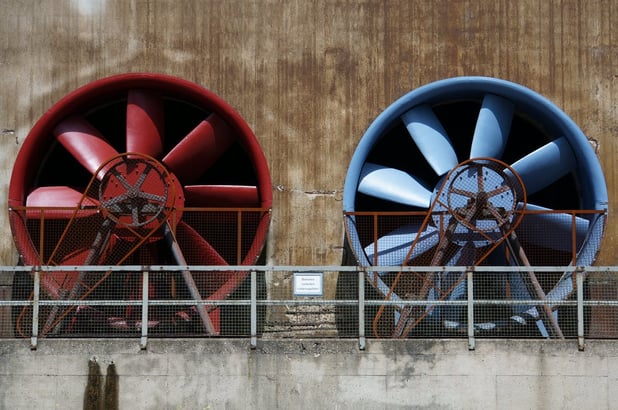How to Boost the Efficiency of Your Air Ventilation System

Adequate fresh air ventilation is a key piece of indoor air quality. In the past, building ventilation was handled in a largely manual fashion and planned around estimates of the maximum occupancy of a space of a certain size. …And, of course, occupants could just crank up fans or open windows if they felt like the air was getting stuffy.
This was an inefficient, mostly inaccurate and not-too-responsive way to handle things. Accidentally over-ventilating could also drive up energy costs for heating, cooling, or fan operation, while under-ventilating could reduce comfort and threaten compliance with acceptable IAQ standards.
Enter Demand Control Ventilation
A Demand Control Ventilation (DCV) system automates the process and helps you to maintain excellent air quality for occupant comfort while also reducing energy costs. The DCV system uses sensors to assess current ventilation demands — based on occupancy and various IAQ readings — and introduce fresh air from outside as needed.
For instance, folks might arrive at the office for work in the morning to a quiet, dormant air ventilation system. The DVC system notices that the building is now occupied, and increases the airflow ventilation to rooms where people are now at work. Sensors track CO2, temperature, humidity, room occupancy, and indoor/outside air pressure to keep track of ventilation needs and adjust the system accordingly.
The result? Lower energy costs, optimized ventilation, better IAQ, and a more comfortable building.
How to Boost Your DCV System’s Efficiency
A DCV system is only as good as its sensors. If all you’re tracking is occupancy, you’re still running the risk of over or under-ventilating, because the system isn’t taking the status of (and differences between) indoor and outdoor air quality into account. Here are a few of the key sensor types to deploy in your HVAC system’s ducts as well as in critical ceiling or wall-mounted locations for optimal performance:
- Pressure Sensors: Pressure sensors in your air handling units (AHUs) offer proof of flow, filter status, and can be used for airflow measurement and as a control point for things like fan speeds or airflow through ductwork. You’ll also be able to monitor building zone pressure to regulate the inflow of outside air.
- Humidity Sensors: Air ventilation systems help facilities maintain control over precise environmental humidity requirements. If you’re running a lab, library, manufacturing plant, or other humidity-sensitive facilities, these sensors are key to protecting equipment and processes in the building. Even in office and residential buildings, however, humidity regulation is a critical component of occupant comfort. Humidity sensors within air handling units help you determine how much outside air you need to introduce into the building and keep you timely in your response when RH is exiting the desired range.
- Temperature Sensors: Temperature sensors and thermostats help your DCV system to monitor not only room temperatures, but also duct temperatures, chilled and heated water loops, inside and outside air temperatures, and more. Use temperature setpoints to trigger fans and regulate airflow ventilation as appropriate to the season. If indoor temperatures get too hot or too cold, you can reduce the burden on your heating and cooling units by bringing in outdoor air — but only if it’s more comfortable than the air inside the building.
- CO2 Sensors: One of the best ways to reduce costs on constant conditioning of outside air is to track the CO2 levels for each occupied space inside of your building. Use outputs to have your DCV system either recirculate inside air or introduce fresh air, as needed. While CO2 levels are safe and comfortable (generally about 700 to 1200 ppm for an indoor space), you can relax the influx of outdoor air and save energy by recirculating already-conditioned indoor air.
- Occupancy Sensors: When it comes down to it, building management is about keeping a building cost-efficient but also comfortable. This takes a clear model of how the space is used — where, how long, and in what numbers people are occupying the building. Occupancy detection helps you guide the setpoints and schedules in your system. Air ventilation systems can be turned down or off if certain areas are less active or empty.
- Current Sensors: Adjustable current switches in your AHUs can accurately detect clogged filters, belt loss, coupling shear, or another mechanical failure on unit vents, exhaust fans, recirculation pumps, and other fixed loads.
Talk to an Expert
Have questions about air ventilation systems, airflow measurements, DCV, or indoor air quality? Veris reps are ready to chat through our Virtual Meeting Scheduler. Get the personalized support you need in a convenient online format from the comfort of your home or even on the go. Get the answers you need and get back to work quickly! Just book a virtual meeting, tell us about your project, and we’ll do the rest.





